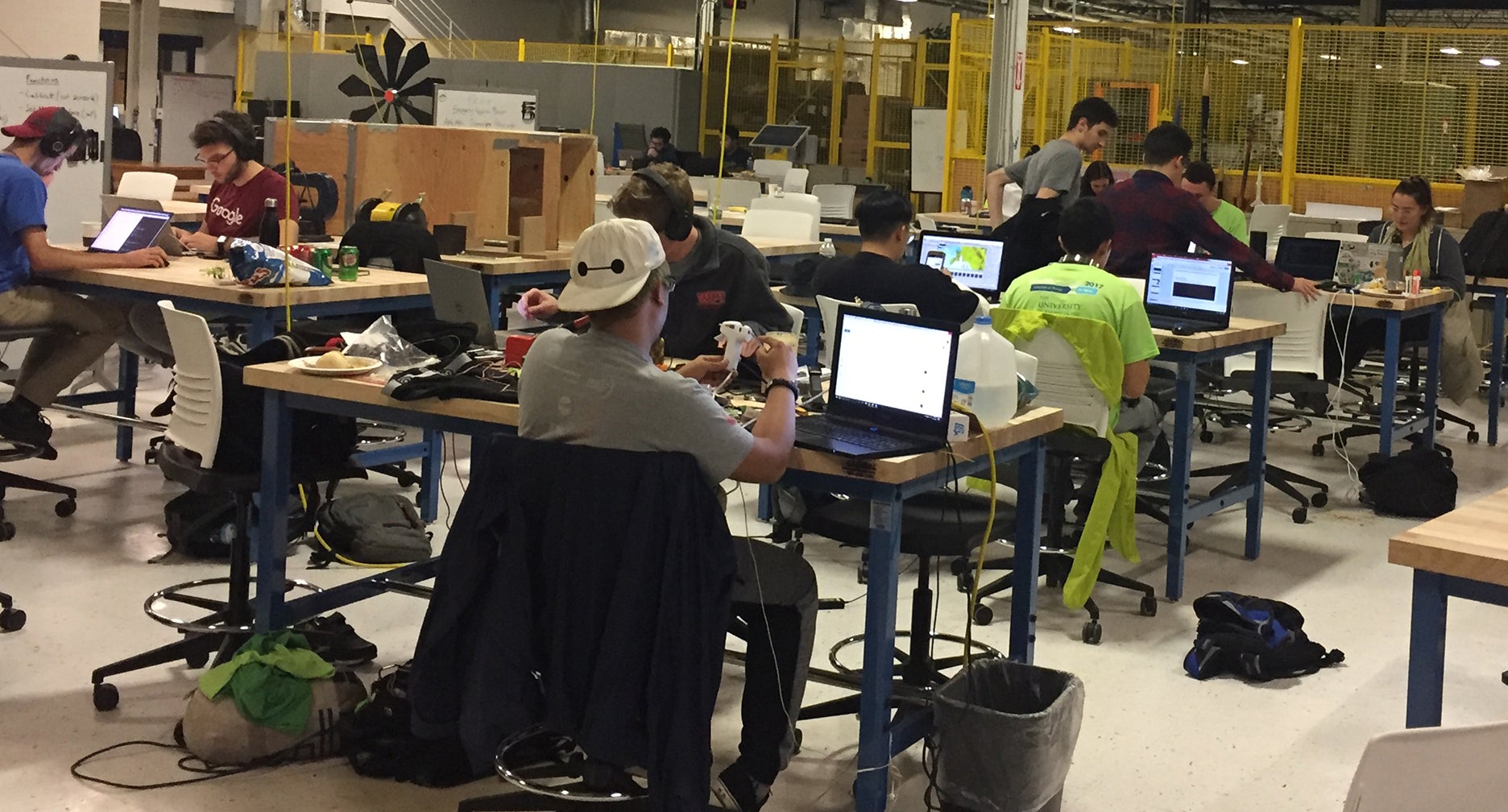KINGSTON, R.I.—Oct. 25, 2017—A team of University of Rhode Island engineering students made its mark at a recent hackathon for creating smart textiles that encourage older adults to flex their muscles.
Dylan Kennedy, of North Kingstown, James Gannon of Coventry, Long Zou, of Westerly, R.I., Dylan Young, of Portsmouth, and Graem Timmons, of York, Maine, were among 36 students competing at Health Hacks RI Oct. 16-18 on the Kingston campus.
“The students chose to spend their weekend brainstorming, and creating and developing devices to improve the lives of older adults,” says URI Director for Entrepreneurship Deedee Chatham. “They are rock-star innovators, and they make me feel optimistic about our future.”
The URI group and nine other teams from throughout the region were given 48 hours to design and build a product that would improve the lives of elderly people.
The teams pitched their products to a panel of judges—in five minutes or less—then answered questions for two minutes. Besides placing third, the URI team also received $250.
The group designed smart clothing that tracks muscle loss among elderly people. They also created an app that suggests activities to strengthen under-used muscles.
“Our project addressed what, to us, are the most significant issues in aging: sarcopenia (muscle loss) and cognitive decline,” says Young, a junior studying biomedical engineering. “Our approach targeted both issues simultaneously through wearable technology.”
First, the team stitched silver-coated conductive fibers into a T-shirt to mimic an EMG, or electromyogram, which measures the electrical activity of muscles at rest and in use. Unlike a common EMG, the students’ method did not require pasting bulky electrodes onto a patient’s skin.
Instead, a patient could be monitored by simply getting dressed. The biosensor was then wired to a microcontroller with Bluetooth capabilities.
The EMG data were transmitted over WiFi to an app the students designed to compare measured and healthy muscle activity. The app could recommend physical activities on the patient’s cell phone to prevent muscle loss.
“This part of our project was truly novel,” says Young. “Rather than instructing an elderly, likely sedentary, patient to perform exercises they were unlikely to do, we recommended different activities. In the case of bicep inactivity, for example, the app would recommend that the patient paint or water the garden instead of picking up a dumbbell.”
The group brainstormed about several possible products, but nothing jumped out until Young and Timmons went to dinner with Dr. John Luo, chief executive officer of Doctor’s Choice and a mentor at the event.
“Johnny started explaining some of the techniques that can help focus idea development,” says Timmons, a junior majoring in biomedical engineering and computer science. “He asked Dylan and me what we would do for a project if we ignored obstacles we might face. We explained our thoughts, with some reservation. As we parsed through the project, it began to seem more realistic.”
The time constraint added some pressure. “I think the most challenging part about Health Hacks was that we had very limited time to brainstorm a concrete idea, design a product and develop a marketing plan,” says Zou, a junior studying electrical engineering.
The students, however, were grateful for the opportunity. “The hackathon gave me immediate hands-on experience where I had the chance to create, question, struggle and collaborate with a team of imaginative people,” says Gannon, a junior majoring in electrical engineering and Spanish. “It is such a mind-opening experience to address real-world problems by taking lines drawn on a whiteboard and developing that idea into a product.”
“My biggest takeaway from this experience is that it showed me how much can be accomplished in a short period of time if you set your mind to it,” says Young. “I think doing something like this will help me be more productive with my general school work.”
Students were judged on design, market value, scalability/ manufacturability, idea originality and implementation. Judges were from URI, Brown University, Rhode Island School of Design, Worcester Polytechnic Institute and Ximedica. Entrepreneurs from New York City and Rhode Island were also judges.
Worcester Polytechnic Institute won first place, and $1,000, for designing motion-tracking undergarments to allow patients recovering from hip surgery to have in-home physical therapy. University of Massachusetts, Dartmouth, won second place, and $500, for inventing a device that more accurately detects falls.

